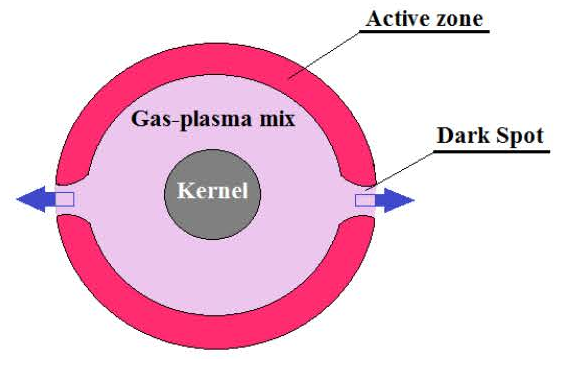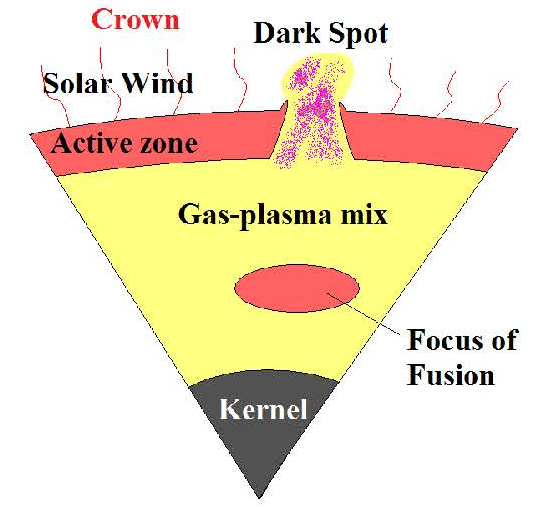4.5. «A solar wind»
We have considered how the Sun is arranged, using the new theory developed by us, based on the laws of classical physics. If we lean on the theory given, we see that the information on a solar wind gives us an invaluable knowledge of the star and gives another, absolutely more powerful value. For the analysis of the solar wind it is necessary to define the sources and the nature of its formation.
— Sources of «a solar wind»
Sources of a solar wind are:
— «The active zone» — a zone where the thermonuclear synthesis leads to allocation of most of the energy, is the top part of the atmosphere: the photosphere, the chromosphere, and the bottom part of the crown;
— «Dark spots» — place of break of the gas-plasma mix on a surface of the Sun, through «the active zone». It’s probably possible to add coronary holes to this list, but their deeper studying is necessary for this purpose.
— The nature of formation of «a solar wind»
— In the active zone there are thermonuclear reactions of synthesis in which, kernels and particles receive an impulse during the moment of energy allocation and are a part of the solar wind.
— In «the dark spot» — throttling of the gas-plasma mix occurs (fig. №R-4.12), and the emission of gas-plasma mix, during the nuclear explosions inside the stars (fig. №R-4.13). Particles, atoms and kernels receive high speed due to the expiration in space of gas and plasma, through the hole in the active zone. Since in the nutria of a star, the gas-plasma mix has high values of temperature and pressure, in this case it is possible to hit in the structure «solar wind» of kernels that are heavier than Zn and of kernels in which the synthesis occurs, without the energy allocation, or with minimum allocation.
(63) Figure № R-4.12
The reasons of the powerful solar flashes with the formation of «dark spots» might be the powerful nuclear explosions inside of the star.
A powerful explosion in a star occurs at generation of thermonuclear synthesis, and it is possible, that as a result of nuclear reactions of division during the accumulation of heavy kernels. Powerful short-term explosions are transient allocation of a large quantity of energy in a star.
That means, the energy allocated in the star, can exceed the star’s possibility to absorb and to process this energy in time.
In these cases come the critical moments, when the concentration and allocation of energy in the star is more than energy the allocated from the active zone, and directed inside the stars. In these cases there is a break of the active zone and the «excess» energy is thrown out in space. If, the environment of the star would be rigid, or an allocation of plenty of energy would take longer time, the star would collapse. Hence, «the active zone» of the stars, is not only a «safety valve» for the gas-plasma mix, but also a power safety lock, dumping the critical quantity of energy into space, saving the star from destruction and death.
(64) Figure №R-4.13
The analysis of plasma thrown out from the «dark spots» enables to define the chemical compound of the gas-plasma mix of the star and its physical parameters: temperature, pressure and probably volume.
— The analysis of parameters of «a solar wind»
Key parameters of «the solar wind»: chemical compound, kind of radiation, speed of radiation, temperature and energy of «the solar wind».
What information on the star the analysis of the solar wind parameters can give us?
First, what reactions of synthesis occur in a star?
Some variants are probable:
— Synthesis of two any kernels;
— Synthesis of two kernels, one of which is hydrogen or the helium having high speeds.
— Synthesis of high-speed easy kernels, in the active zone and less high-speed kernels inside of the star, under the action of superfluous dynamic pressure created by the active zone.
— Simultaneous synthesis of more than two kernels.
— Simultaneous synthesis of more than two kernels, most of which are the easy kernels having high speeds.
— Simultaneous synthesis of more than two high-speed kernels in the active zone, and synthesis of heavier kernels inside of the star under the action of pressure created by the active zone.
Each of these variants of synthesis has the following characteristics: chemical compound, speed of kernels and particles, character of radiation, a spectrum energies scale-radiations,
X-ray radiation, neutrino radiation, spectrum of energy, radiations and particles, temperatures of particles, kernels, and other characteristics.
Second — it is also possible to define based on the chemical compound, radiations from «dark spots»:
— what reactions are possible inside of the star;
— the chemical compound of the gas-plasma mix;
— what stage of living the star going through.
Third – by the speed and temperature of plasma radiation from the dark spots it is possible to define the temperature and pressure of the gas-plasma mix below the active zone.
Also, the analysis of maps and photos made in different beams and radiations can give us answers to many questions. Such analysis is necessary to be conducted considering the displacement time in the information reception, since the speeds of the solar wind, radiations and electromagnetic waves (light) are different.
Let’s disassemble which factors can influence the parameters of «a solar wind»:



